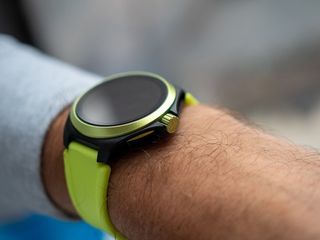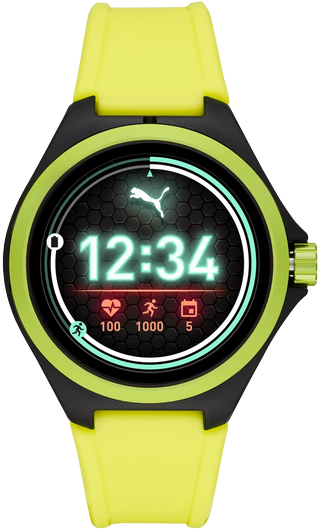Android Central Verdict
Bottom line: The Puma Smartwatch has the looks and brand to pick up sales from those who want to keep things sporty and exercise without being encumbered by a fragile, or larger, smartwatch. It's light and easy to wear every day, the display gets the job done, and GPS and heart rate tracking are also good. But Wear OS still has bugs and a weak app ecosystem, 512MB of RAM just isn't enough to properly run this software, and battery life maxes out at one day.
Pros
- +
Wear OS is slick and simple
- +
Lightweight and durable case
- +
Good GPS and heart rate tracking
- +
Nice-looking display
Cons
- -
Cheap-feeling plastic build
- -
Slow and inconsistent performance
- -
1-day battery life at best
- -
Low-quality third-party apps
- -
No sleep tracking
Why you can trust Android Central
Fossil's biggest accomplishment in smartwatches is being able to bring together an incredibly diverse set of well-known brands under a common platform. It's unlikely that Puma would be able (or willing) to make a competent smartwatch on its own, so this partnership with Fossil is a complete win-win like every other brand partner. Puma gets to leverage its well-known brand and design capabilities, and let Fossil handle the internals and capabilities.
The result is a Wear OS watch that feels incredibly familiar, sharing its platform with several other smartwatches, but one with a unique style that separates it from the rest of the fashion-focused market.
The best Android smartwatches you can buy
Puma Smartwatch What I like



Not everyone wants a "fashion" smartwatch that's focused on being classy or flashy with polished metal and stylish accouterments. There's a huge market for sporty watches that put function over form, or generally fit an active lifestyle aesthetic; and the Puma Smartwatch is here for those buyers.
Not everyone wants a "fashion" smartwatch — some want something sporty and robust.
Whether you pick the dayglow yellow version like I have here, or the more subtle color choices, the Puma Smartwatch feels right at home when you're out for a run, in the gym or wearing casual clothes on the weekend. It's a simple design with a round and smooth dial surrounded by an angular body with cutouts for a cool two-tone look. The hardware is matched well by Puma's unique watch faces — although it only has four, and you'll have to go to the Play Store if you want any sort of variety.
Some will see this design as a downside considering you can't really incorporate the Puma Smartwatch into more formal or dressy attire, but you know that going in. If you need a smartwatch that can better walk the line between casual and formal, there are plenty of other options.
The Puma Smartwatch is light and small enough to handle any activity.
The active nature goes beyond just looks. The primarily plastic casing (Puma says there's aluminum in here, but I sure can't tell) is sturdy and ready to take its fair share of abuse, and it's rather freeing to have a "basic" casing that you aren't worried about keeping pristine. The Puma Smartwatch will wear its battle scars as well as your running shoes.
It's also practical for that sort of use: this watch is incredibly light and easy to wear without any discomfort. The nice-looking 1.19-inch display fits into a casing that's 44 mm across and 11 mm thick, and at just 28 grams is incredibly light. The crown is smartly protected so it isn't likely to snag on clothing. The band doesn't look particularly high quality, but it too is comfortable and super-light, and never rubbed my wrist or snagged arm hair even during workouts.
GPS and heart rate tracking were both accurate, which I greatly appreciate seeing in a general-purpose smartwatch. Google Fit has also improved quite a bit over the last couple of years. And you can of course install third-party apps like Strava — though the Strava app is incredibly basic, only supporting outdoor running and biking.
Puma Smartwatch What I don't like



Sure it's supposed to be light, but this thing just feels downright cheap and plasticky.
I appreciate how light the Puma Smartwatch is, but the other side of that coin is that it just feels cheap on the wrist. I switched to the Puma Smartwatch after several weeks wearing the similarly-priced Galaxy Watch Active 2, and the quality and feel are dramatically different. It's amazing what better materials can bring to the table. Again you know what you're getting into with a "sport" watch, but I was hoping for a bit of a better balance of quality for $275.
That's really the only complaint that can be had in terms of hardware; the rest of the shortcomings are all in software.
Wear OS is a set of great ideas with very weak execution.
I actually really like Wear OS from a design and simplicity perspective. It's slick and easy to navigate, and the integration with Android for notifications and Google's apps is seamless. The use of a rotating crown is an excellent interaction paradigm. But it has so many issues: the software is oddly unstable, battery life maxes out at a day (though there's no sleep tracking anyway), and there are weird blind spots like Do Not Disturb not syncing with your phone that just make the whole experience feel unfinished and incomplete. My watch also had a very odd habit of randomly completely freezing, leaving the always-on display stuck at a specific time with the only recourse being a long-press of the crown for several seconds to reboot it.
Every Wear OS watch should have at least 1GB of RAM — the Puma Smartwatch is a perfect example of why.
I know this isn't something that Puma (or Fossil) really has any control over considering Wear OS is controlled by Google, but it's still the experience you have to deal with no matter where you place the blame. And it's also the common playing field for all Wear OS watches — if you don't like the software, you can't skip the Puma Smartwatch and pick up a Fossil Gen 5 and expect anything dramatically different.
But the one exception in that discussion is the Puma Smartwatch's specs. There's a reason why Fossil now puts 1GB of RAM in most of its latest-generation watches. Wear OS really needs that gig, and all it takes is using the Puma Smartwatch to remind you why. The Puma Smartwatch randomly drags along at some of the most basic tasks, like opening apps or moving between the main interface panels, and it really detracts from the overall experience — compared to other Wear OS watches, but the speed of Samsung's wearables in particular.
Puma Smartwatch Should you buy it?

In general, it'd be pretty easy to recommend the Puma Smartwatch. It's a proper sport watch that goes all-in on active styling. It's light enough to wear for any sort of activity, and robust enough to hold up to rough treatment. It's not styled for everyone (or every sort of attire), and its plastic feels incredibly cheap, but it offers just what this kind of buyer wants.
3 out of 5
This is the sporty smartwatch we want to see, but it's held back by a couple big shortcomings.
The Puma Smartwatch is just unfortunately let down by a couple of bad decisions in its hardware, and by running Wear OS software that immediately puts it at a disadvantage. I just can't recommend a Wear OS watch that only has 512MB of RAM, when there are so many other options based on the Fossil Gen 5 platform with 1GB that have dramatically better software performance. The Puma Smartwatch as a whole is really hampered by its performance. And Wear OS a whole still feels unfinished, with weak battery life, odd instability and lackluster third-party apps.
If you're willing to stick with Wear OS, you can find a Fossil Sport for about $150, saving you money for the same general experience and sporty design. But if you can spend $275 on a Puma, I'd recommend a Fossil Gen 5 for $295 instead.
Unless you're particularly drawn to Wear OS, the Galaxy Watch Active 2 is a better sports-focused smartwatch for the money. It feels better on the wrist, and has a nice neutral design that can easily be dressed up or down. It has the specs necessary to run its software smoothly all the time, and battery life that can go two full days with sleep tracking in between. It looks a little generic, and doesn't have Wear OS's simplicity, but it otherwise beats out the Puma Smartwatch in all respects.

A nice sporty watch that would really benefit from better specs.
The Puma Smartwatch is a nice sports watch that breaks the trend of "fashion" Wear OS watches. But it really needs more memory to perform properly, and its plastic body also feels downright cheap for the money.
Andrew was an Executive Editor, U.S. at Android Central between 2012 and 2020.

